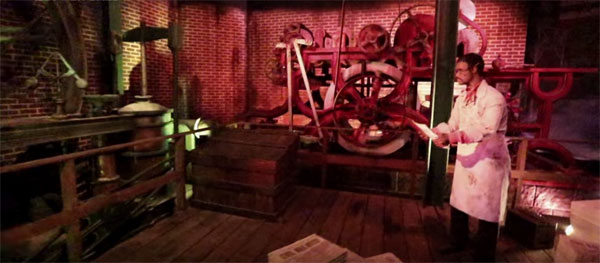
The advances keep coming as we blitz through the upward section of Spaceship Earth and the age of invention. Beginning with a steam-powered printing press from 1863, the scenes progress quickly. Technology is evolving full steam ahead, and there’s no way to stop it. Jeremy Irons aptly describes both the excitement and quick changes:
“On this wave of inspiration, we sailed into a bold, new era of communication bringing an explosion of tools and technologies which would bridge people around the world as never before. And as our appetite for information and knowledge grew, the world began to shrink.“
Irons’ final point about the shrinking world connects directly to placement of scenes here. We don’t spend much time pondering each invention. The first stop is the large printing press scene with a young boy selling newspapers nearby. According to Jim Korkis, the steam press was designed from William Bullock’s patent drawings in 1863. In the current version, the boy faces away from the ride vehicles. Art Director Neil Engel explained to me that the executive producer disliked the boy and requested the switch. They also inserted a new drop painting to create the street near the boy.
Even with the boy facing away, it’s still an impressive scene that conveys a fast-paced world. We quickly progress through each invention with only a few moments separating each one. In the Jeremy Irons version in 1994, the newsboy has a lot more dialogue. These lines explain that a telephone has crossed the Atlantic, a clever way to impart that information. In 2007, the boy explains the end of The Civil War in 1865. The headline was a last-minute insertion according to Engel, and it necessitated the removal of snow meant for this scene with Lee’s surrender happening in April.
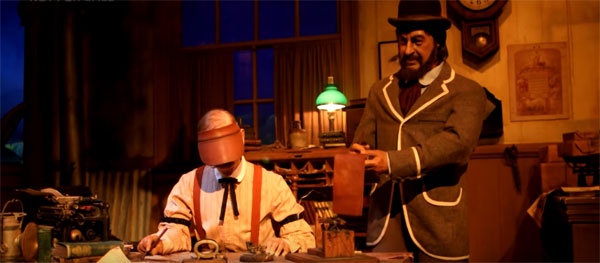
Focusing the Story
The next scene shows two men using the telegraph to pass along information about completion of the Transcontinental Railroad in 1869. The details are excellent, including the outfits of both guys with suspenders and hats. For 2007, the seated man states the key line that “America…now connected from the Atlantic and the Pacific”. The dialogue is basic in the earlier versions, and the operators sound weirdly sleepy. Engel noted that they repainted the backdrop and lit it with blacklight to create an evening atmosphere and add depth, plus new decorations, for today’s version.
Turning to our left, we see a switchboard that has been in place since the original. Two women are seated while another stands and takes phone calls. It’s a quick scene but is all we need to understand the next phase of communication. We also see the shadow of people using phones in the windows behind this scene. It’s difficult to catch everything on a single ride. The Imagineers dropped a lot within a small space. Korkis explains that the switchboard was built from an actual 1898 model and supplied by AT&T. It’s another cool example of how Disney went beyond what was needed.
On the other hand, simplifying the scenes can work wonders. Traveling beneath the lit-up cinema sign, we pass a ticket booth near a movie screen. The current attraction narrows the scope to show Jesse Owens winning gold in the 1936 Olympics. The woman in the booth also now holds a newspaper with a headline about Owens. Multiple screens appeared in the past with shots of Snow White and the Seven Dwarfs and 20,000 Leagues Under the Sea. Once again, the 2007 iteration focuses on a single historical event. I like this move because we can focus better on the scenes, and improved audio supports them well.
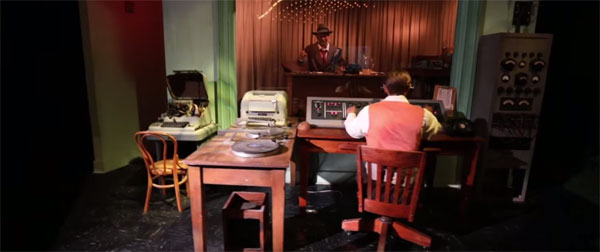
Bringing Us Together
Looking back to our left is a radio booth, which currently announces the landing of Amelia Earhart in Wales after crossing the Atlantic. This event from July 19, 1948 represents another example of an invention connecting to a specific event now. It’s the next stage in entertainment as radio grabs hold in homes. We have moved forward 12 years from the clip of Jesse Owens at the Berlin Olympics. A man records the news inside the studio while another works the controls outside. The clever staging places us behind a desk with a clear view of the performer facing us. The microphone says WDI, which is an obvious nod to Walt Disney Imagineering.
The current scene represents a significant change from the prior version, which depicted a man and woman performing a radio play. The animatronics stood inside the studio with the controller facing away from us. The switch from the radio drama to a news show with the seated announcer changes the tone. In a similar vein to the Jesse Owens switch, it presents the invention as a way to convey information. These mediums keep us informed and don’t just entertain.
This 2007 shift continues in the living room, which focuses on the Apollo 11 moon landing in 1969. Dench introduces the iconic moment with this statement:
“By now, we’re all communicating from anywhere on Earth—and in 1969, from somewhere else.”
Engel decorated this scene to resemble his childhood home in the ’60s. The emphasis on making our world smaller also continues, and it connects the family directly with astronauts on the moon. We also hear Neil Armstrong’s famous line, and it’s a powerful way to remind us of the wonders of technological advances.
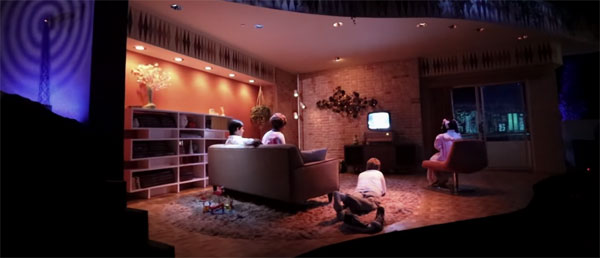
A New Renaissance
Previous versions included TV screens behind the family showing Ozzie and Harriet, Walt Disney introducing the Wonderful World of Color, and more. Multiple entertainment options were novel in the ‘80s and reinforced our expanding communications world. However, I appreciate the more streamlined approach to the story today. The next invention will give us the chance to connect more directly with others through the computer. Like Judi Dench proclaims, we stand on the brink of a new Renaissance. Join me next time to explore giant computers and see our Spaceship Earth!
Sources: Martin’s Videos, Mouseplanet, Secret Stories of Walt Disney World by Jim Korkis
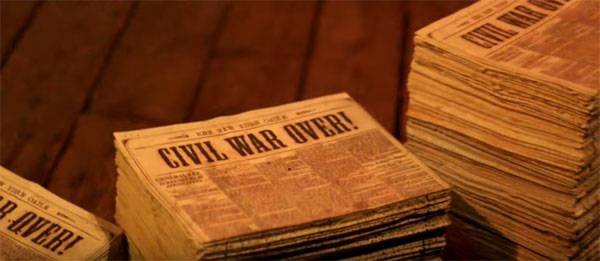
Related Articles: The Age of Invention
Spaceship Earth, Scene by Scene: The Full Series
Five Steps to Enhance Spaceship Earth
This post contains affiliate links. Making any purchase through those links supports this site. See full disclosure.



Thanks for your commitment to this series, Dan! I really enjoy them. I hope that the new rennovations of Spaceship Earth keep the “noble” tone of the original. I’m equal parts worried and excited. To me, Spaceship Earth is the most inspiring man-made object on the planet.
Melanie, I agree and am trying to hope for the best with the upcoming update. The switch to story telling for the main theme has promise and isn’t a huge stretch from the communications focus, but it also opens up the possibility of Disney characters in the attraction. I hope that however it goes, it still has a similar tone to past versions. I’m interested to see what they do!